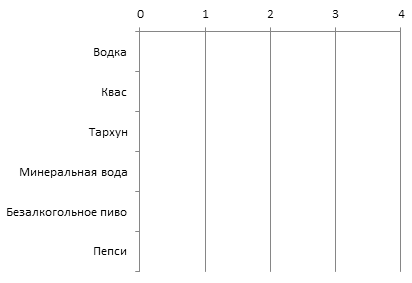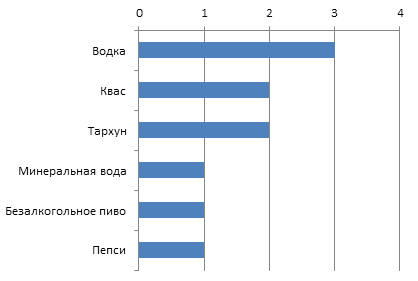A new look at the vote, or popular about the Condorcet Paradox
Those who would like to learn more about such a seemingly insignificant topic as a simple vote - I invite you to the cat.
The article does not claim to historical and scientific accuracy. The author has no scientific publications and other merits on this topic. Nevertheless, the author considers this topic important.
The only mention of the Condorce 's paradox (not to be confused with the Condorcet's jury theorem ) is in the comment by TimTowdy .
CONDORSE Jean-Antoine Nicolas., (1743-1794) [ here is a biography in literary form ] - a mathematician, economist, philosopher, politician (rather, an opposition figure of the overthrow of the French monarchy), author of the book " Sketch of the historical picture of the progress of human reason. " (1794 ) (Think about the name!). Although he was not only and not so much a mathematician, let us dwell only on the mathematical side of his personality. We only note that the policy eventually became the cause of his death.
')
Jean was a friend of D'Alembert, who was 26 years older, and Lagrange. At 23, he presented his first work on integral calculus, which naturally received the best feedback from D'Alembert and Lagrange. After 4 years, he became a member of the French Academy of Sciences, where he was pinned his hopes on the calculation of the trajectories of comets. However, Jean-Antoine did not strive for complete immersion in mathematical theory, but continued to participate in secular, political lifeand gambling , due to which he gradually shifted to probability theory. In 1785 he published the work, denoting in it the concept of Paradoxes Condorce (or Effect Condorcet ). The work was devoted to the problems of making collective decisions during the election of deputies of the provincial assemblies . It should also be mentioned that from the age of 33 he was a member of the Petersburg Academy of Sciences.
Imagine a group of 10 participants, three of whom are loyal to the use of alcoholic beverages (for short, alcoholics), and seven are irreconcilable opponents (for short, sober-tempered). We will provide them with a newsletter for a single (RadioButton) vote on the topic:

It would seem that the opinion of non-drinkers should be decisive, because they are in the majority. But!
It is important to mention Arrow's Theorem , according to which the number of points of a representative vote should be one (like dislike) or two. And also the Schulze Method , according to which a participant must build all voting points in order of their preferences, on the basis of these data a graph is constructedand the daunting task of solving this graph arises . Also, the corresponding links from LJ-user falcao.
We emphasize the importance of the concept of dislikes (point “against”). This is not just an expression of opinion of the disgruntled and skeptical, but an important element of representativeness.
<Politics> The well-known oppositionist urged to vote for any candidate except ... But the fact is that with enough alternatives it only increases the chances of the “except” clause. </ politics>
The most interesting in terms of prospects for discussion are the “controversial” comments, which scored the maximum number of likes + dislikes in approximately equal proportions. It makes sense to make this data in the ratings.
UPD:
Thanks to the distinguished unknown participant who gave me an invite! Grateful, for the honor rendered to me in the form of acceptance into the honorable Habra community.
Disclaimer
The article does not claim to historical and scientific accuracy. The author has no scientific publications and other merits on this topic. Nevertheless, the author considers this topic important.
We check habr
The only mention of the Condorce 's paradox (not to be confused with the Condorcet's jury theorem ) is in the comment by TimTowdy .
Little about Condorcet
CONDORSE Jean-Antoine Nicolas., (1743-1794) [ here is a biography in literary form ] - a mathematician, economist, philosopher, politician (rather, an opposition figure of the overthrow of the French monarchy), author of the book " Sketch of the historical picture of the progress of human reason. " (1794 ) (Think about the name!). Although he was not only and not so much a mathematician, let us dwell only on the mathematical side of his personality. We only note that the policy eventually became the cause of his death.
')
Jean was a friend of D'Alembert, who was 26 years older, and Lagrange. At 23, he presented his first work on integral calculus, which naturally received the best feedback from D'Alembert and Lagrange. After 4 years, he became a member of the French Academy of Sciences, where he was pinned his hopes on the calculation of the trajectories of comets. However, Jean-Antoine did not strive for complete immersion in mathematical theory, but continued to participate in secular, political life
What's the point
Imagine a group of 10 participants, three of whom are loyal to the use of alcoholic beverages (for short, alcoholics), and seven are irreconcilable opponents (for short, sober-tempered). We will provide them with a newsletter for a single (RadioButton) vote on the topic:
What kind of drinks should be more on store shelves

It would seem that the opinion of non-drinkers should be decisive, because they are in the majority. But!
See the results

What kind of drinks should be more on store shelves

What's next
It is important to mention Arrow's Theorem , according to which the number of points of a representative vote should be one (like dislike) or two. And also the Schulze Method , according to which a participant must build all voting points in order of their preferences, on the basis of these data a graph is constructed
Margin notes
We emphasize the importance of the concept of dislikes (point “against”). This is not just an expression of opinion of the disgruntled and skeptical, but an important element of representativeness.
<Politics> The well-known oppositionist urged to vote for any candidate except ... But the fact is that with enough alternatives it only increases the chances of the “except” clause. </ politics>
The most interesting in terms of prospects for discussion are the “controversial” comments, which scored the maximum number of likes + dislikes in approximately equal proportions. It makes sense to make this data in the ratings.
UPD:
Thanks to the distinguished unknown participant who gave me an invite! Grateful, for the honor rendered to me in the form of acceptance into the honorable Habra community.
Source: https://habr.com/ru/post/184342/
All Articles